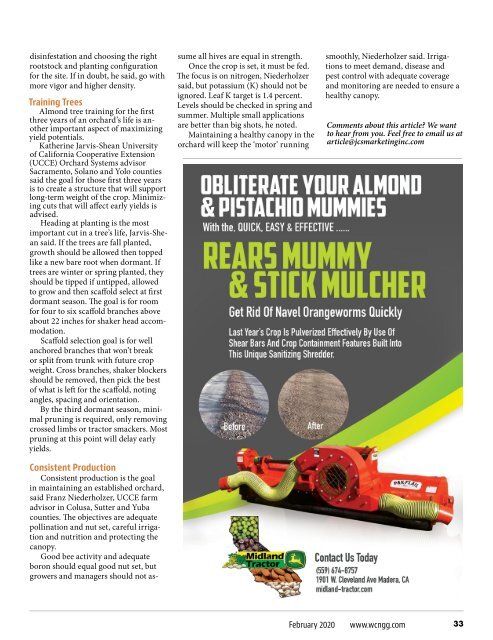Create successful ePaper yourself
Turn your PDF publications into a flip-book with our unique Google optimized e-Paper software.
disinfestation and choosing the right<br />
rootstock and planting configuration<br />
for the site. If in doubt, he said, go with<br />
more vigor and higher density.<br />
Training Trees<br />
Almond tree training for the first<br />
three years of an orchard’s life is another<br />
important aspect of maximizing<br />
yield potentials.<br />
Katherine Jarvis-SheanUniversity<br />
of California Cooperative Extension<br />
(UCCE) Orchard Systems advisor<br />
Sacramento, Solano and Yolo counties<br />
said the goal for those first three years<br />
is to create a structure that will support<br />
long-term weight of the crop. Minimizing<br />
cuts that will affect early yields is<br />
advised.<br />
Heading at planting is the most<br />
important cut in a tree’s life, Jarvis-Shean<br />
said. If the trees are fall planted,<br />
growth should be allowed then topped<br />
like a new bare root when dormant. If<br />
trees are winter or spring planted, they<br />
should be tipped if untipped, allowed<br />
to grow and then scaffold select at first<br />
dormant season. The goal is for room<br />
for four to six scaffold branches above<br />
about 22 inches for shaker head accommodation.<br />
Scaffold selection goal is for well<br />
anchored branches that won’t break<br />
or split from trunk with future crop<br />
weight. Cross branches, shaker blockers<br />
should be removed, then pick the best<br />
of what is left for the scaffold, noting<br />
angles, spacing and orientation.<br />
By the third dormant season, minimal<br />
pruning is required, only removing<br />
crossed limbs or tractor smackers. Most<br />
pruning at this point will delay early<br />
yields.<br />
Consistent Production<br />
Consistent production is the goal<br />
in maintaining an established orchard,<br />
said Franz Niederholzer, UCCE farm<br />
advisor in Colusa, Sutter and Yuba<br />
counties. The objectives are adequate<br />
pollination and nut set, careful irrigation<br />
and nutrition and protecting the<br />
canopy.<br />
Good bee activity and adequate<br />
boron should equal good nut set, but<br />
growers and managers should not assume<br />
all hives are equal in strength.<br />
Once the crop is set, it must be fed.<br />
The focus is on nitrogen, Niederholzer<br />
said, but potassium (K) should not be<br />
ignored. Leaf K target is 1.4 percent.<br />
Levels should be checked in spring and<br />
summer. Multiple small applications<br />
are better than big shots, he noted.<br />
Maintaining a healthy canopy in the<br />
orchard will keep the ‘motor’ running<br />
smoothly, Niederholzer said. Irrigations<br />
to meet demand, disease and<br />
pest control with adequate coverage<br />
and monitoring are needed to ensure a<br />
healthy canopy.<br />
Comments about this article? We want<br />
to hear from you. Feel free to email us at<br />
article@jcsmarketinginc.com<br />
<strong>February</strong> <strong>2020</strong><br />
www.wcngg.com<br />
33


















